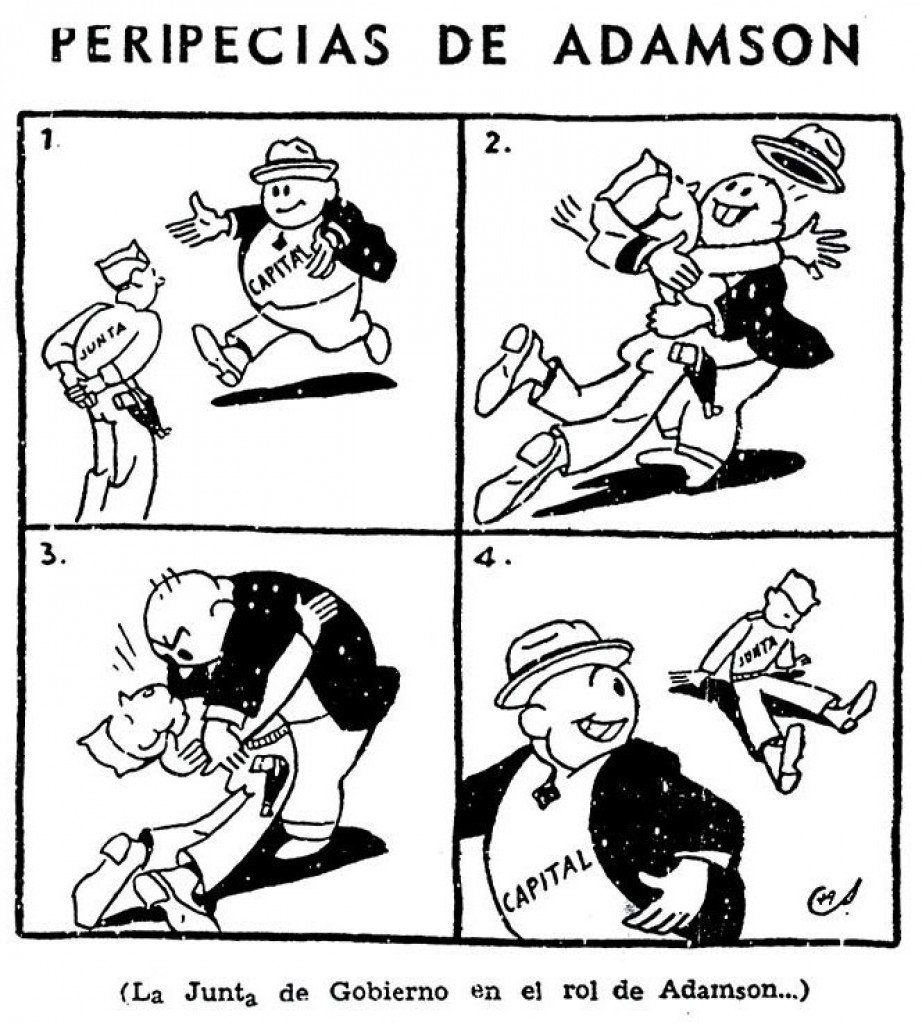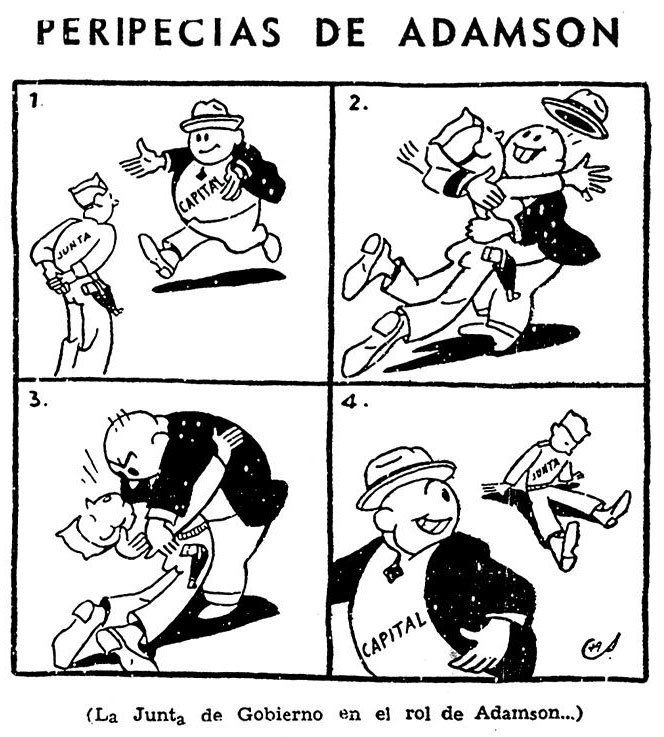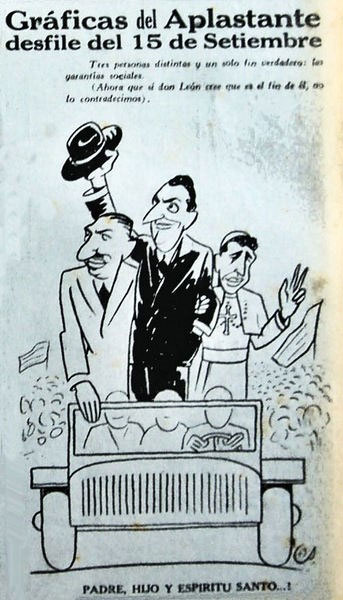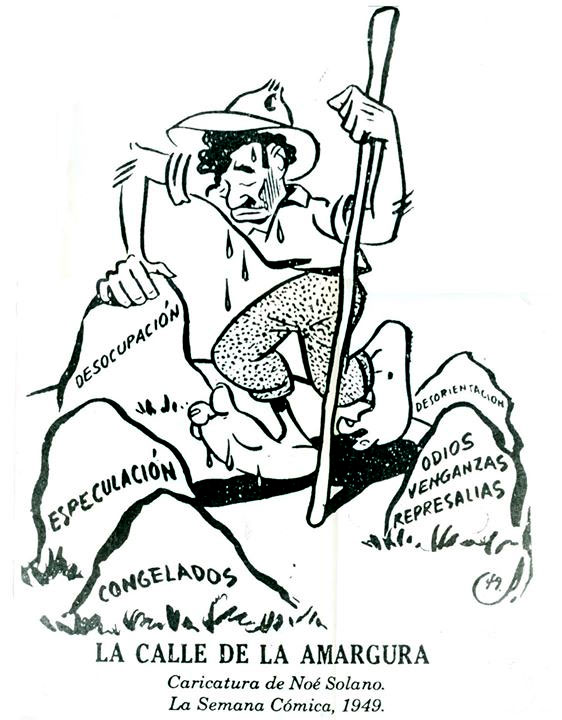Comic strip from La Semana Cómica: capitalism suffocates the government in embrace.
Noé Solano Vargas was an early- to mid-20th century Costa Rican humorist, cartoonist and comic artist. He was a pioneer in Costa Rican graphic humor in general and comic art in particular. Besides working for several of the country's newspapers and magazines between 1920 and 1960, Solano was also a journalist, editor and promoter of cartoons as an art form.
Early life and career
Born in 1899, Noé Solano Vargas received his academic training at the National School of Fine Arts, headed in San José by the Spanish immigrant painter Tomás Povedano de Arcos. He continued his artistic education in Cuba and the United States. Between 1920 and 1960, the artist worked for a variety of newspapers, not only from Costa Rica, but also from Cuba. These included El Diario de Costa Rica, La Tribuna, La Linterna, El Látigo, El Nacionalista, Don Lunes, Diario Nacional, Repertorio Americano, La Prensa Libre and La Nación.
Bohemia & La Semana Cómica
Solano Vargas was co-founder, artistic director and main cartoonist for the magazine Bohemia (1922-1924), in which he first combined humor with commentary on national events. By the time he joined Pío Luis Acuña's humorous weekly La Semana Cómica in 1935, Solano was already a well-known cartoonist in his home country. Solano quickly became the magazine's main contributor, not only of single panel cartoons but also sequential narratives.
'Padre Hijo', depicting Costa Rican president Rafael Ángel Calderón Guardia, vice president Teodoro Picado Michalski and bishop Victor Sanabria.
Themes
With his groundbreaking work, Solano Vargas participated in establishing Costa Rica's national identity and collective memory. Recurring characters in his drawings were a little puppy and a farmer with big feet and fingers called 'Candelario'. Solano was a supporter of President Rafael Ángel Calderón Guardia (1940-1944) whose social reforms improved the conditions of the working class. In one of his drawings he depicted Calderón, his successor Teodoro Picado Michalski and spiritual leader Monsignor Víctor Sanabria as "Father, Son and Holy Spirit". Solano's main message was the importance of national unity over ideological discrepancies. He was however critical of President Otilio Ulate Blanco (1949-1953), whose victory during the 1948 elections over Caldéron was denied by the legislature, leading to the 44-day Costa Rican Civil War led by José Figueres Ferrer.
Graphic contributions
Solano Vargas' fame also led to illustration assignments, most notably for Carlos Fernández Mora's classic book about Costa Rican politics, 'Anecdotario Nacional', where his art appeared alongside that of Álvaro García López (Garlo) and Juan Manuel Sánchez. He also illustrated political reports for the Leon Cortés Castro (1936-1940) and Caldéron (1940-1944) administrations, as well as the poetry and prose collection 'Música Sencilla' (1928) by Blanca Milanés. The artist passed away in 1971.
Recognition
Appearing in many Costa Rican newspapers and magazines, Noé Solano was well respected within artistic circles. A strong advocate of graphic humor, he exhibited his work in many of the Plastic Arts Exhibitions in the capital's Teatro Nacional from 1928 onwards. He earned Gold Medals during three editions (1928, 1930, 1931) and by 1956 he was awarded the SIP-Mergenthaler prize, one of the highest caricature awards in Latin America.
Legacy
Even though Costa Rica never developed a strong national tradition of cartoon and comic art, Noé Solano and his contemporary Paco Hernández paved the way for later satirical cartoonists like Hugo Díaz Jiménez, Fernando Zeledón Guzmán and Oscar Sierra Quintero (Oki).
Cartoon by Noé Solano Vargas for La Semana Cómica, 1949.





